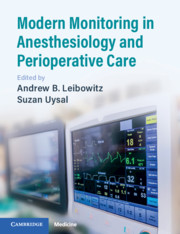Book contents
- Modern Monitoring in Anesthesiology and Perioperative Care
- Modern Monitoring in Anesthesiology and Perioperative Care
- Copyright page
- Contents
- Contributors
- Preface
- Chapter 1 Statistics Used to Assess Monitors and Monitoring Applications
- Chapter 2 Multimodal Neurological Monitoring
- Chapter 3 Cerebral Oximetry
- Chapter 4 The Oxygen Reserve Index
- Chapter 5 Point-of-Care Transesophageal Echocardiography
- Chapter 6 Point-of-Care Transthoracic Echocardiography
- Chapter 7 Point-of-Care Lung Ultrasound
- Chapter 8 Point-of-Care Ultrasound: Determination of Fluid Responsiveness
- Chapter 9 Point-of-Care Abdominal Ultrasound
- Chapter 10 Noninvasive Measurement of Cardiac Output
- Chapter 11 Assessing Intravascular Volume Status and Fluid Responsiveness: A Non-Ultrasound Approach
- Chapter 12 Assessment of Extravascular Lung Water
- Chapter 13 Point-of-Care Hematology
- Chapter 14 Assessment of Intraoperative Blood Loss
- Chapter 15 Respiratory Monitoring in Low-Intensity Settings
- Chapter 16 The Electronic Health Record as a Monitor for Performance Improvement
- Chapter 17 Future Monitoring Technologies: Wireless, Wearable, and Nano
- Chapter 18 Downside and Risks of Digital Distractions
- Index
- Plate Section (PDF Only)
- References
Chapter 11 - Assessing Intravascular Volume Status and Fluid Responsiveness: A Non-Ultrasound Approach
Published online by Cambridge University Press: 28 April 2020
- Modern Monitoring in Anesthesiology and Perioperative Care
- Modern Monitoring in Anesthesiology and Perioperative Care
- Copyright page
- Contents
- Contributors
- Preface
- Chapter 1 Statistics Used to Assess Monitors and Monitoring Applications
- Chapter 2 Multimodal Neurological Monitoring
- Chapter 3 Cerebral Oximetry
- Chapter 4 The Oxygen Reserve Index
- Chapter 5 Point-of-Care Transesophageal Echocardiography
- Chapter 6 Point-of-Care Transthoracic Echocardiography
- Chapter 7 Point-of-Care Lung Ultrasound
- Chapter 8 Point-of-Care Ultrasound: Determination of Fluid Responsiveness
- Chapter 9 Point-of-Care Abdominal Ultrasound
- Chapter 10 Noninvasive Measurement of Cardiac Output
- Chapter 11 Assessing Intravascular Volume Status and Fluid Responsiveness: A Non-Ultrasound Approach
- Chapter 12 Assessment of Extravascular Lung Water
- Chapter 13 Point-of-Care Hematology
- Chapter 14 Assessment of Intraoperative Blood Loss
- Chapter 15 Respiratory Monitoring in Low-Intensity Settings
- Chapter 16 The Electronic Health Record as a Monitor for Performance Improvement
- Chapter 17 Future Monitoring Technologies: Wireless, Wearable, and Nano
- Chapter 18 Downside and Risks of Digital Distractions
- Index
- Plate Section (PDF Only)
- References
Summary
Estimation of intravascular volume status by clinical examination and static measurements such as central venous pressure and pulmonary capillary wedge pressure do not predict fluid responsiveness. Current evidence indicates that dynamic monitoring of arterial pressure and derived indices are the most sensitive and specific means of determining fluid responsiveness, especially in mechanically ventilated patients. Several monitors that automate and embellish this approach, a few of which are noninvasive, are now commercially available and they are gradually being incorporated into intensive and perioperative care practice. This chapter reviews the physiologic underpinnings of how and why the arterial pressure waveform can be used to determine fluid responsiveness and gives an overview of the devices incorporating these principles.
Keywords
- Type
- Chapter
- Information
- Modern Monitoring in Anesthesiology and Perioperative Care , pp. 109 - 116Publisher: Cambridge University PressPrint publication year: 2020
References
- 1
- Cited by

